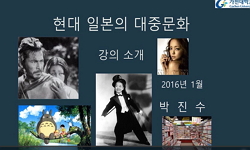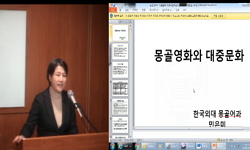The emergence of the first theatre(Hŭidae or Hyŏmnyulsa) made changes in the performing art history of Korea as well as in the social and cultural environment. Because the whole precess of the establishment, operation and abolition of Hŭidae or Hy�...
http://chineseinput.net/에서 pinyin(병음)방식으로 중국어를 변환할 수 있습니다.
변환된 중국어를 복사하여 사용하시면 됩니다.
- 中文 을 입력하시려면 zhongwen을 입력하시고 space를누르시면됩니다.
- 北京 을 입력하시려면 beijing을 입력하시고 space를 누르시면 됩니다.

대한제국기 황실극장의 대중극장으로의 전환 과정에 대한 연구: 희대·협률사를 중심으로 = Converting Process from Imperial Theatre to Public One in Korean Empire Era
한글로보기https://www.riss.kr/link?id=A104197771
-
저자
권도희 (서울대학교)
- 발행기관
- 학술지명
- 권호사항
-
발행연도
2015
-
작성언어
Korean
-
주제어
Korean Empire ; Hŭidae ; Hyŏmnyulsa ; Ch'inggyŏngŭishik ; Karye ; diplomatic ceremony ; Saak ; Kungnaebu ; the Russo-Japanese War ; the royal finance ; the imperial performing products ; popular culture ; Korean emperor Kojong ; Yip'ilhwa ; Songbyŏngjun ; Kat'o Masŭo ; Changbonghwan ; Kimyongje ; Yeoak(Gwangi) ; Gwangdae ; 대한제국 ; 희대 ; 협률사 ; 칭경의식 ; 가례 ; 외교의례 ; 사악 ; 궁내부 ; 러일전쟁 ; 황실재정 ; 황실공연물 ; 대중문화 ; 고종황제 ; 이필화 ; 송병준 ; 가토 마스오 ; 장봉환 ; 김용제 ; 여악(관기) ; 광대
-
등재정보
KCI등재
-
자료형태
학술저널
-
수록면
97-129(33쪽)
-
KCI 피인용횟수
6
- 제공처
- 소장기관
-
0
상세조회 -
0
다운로드
부가정보
다국어 초록 (Multilingual Abstract)
Because Ch'inggyŏngŭishik of Korean Empire was new ceremony to display Korean Empire as an independent modern nation. it amalgamated traditional ceremonial system crossing Karye and Pinlye which were two of five protocols in older Ohrye system with newly western-styled ceremonye. Then the Russo-Japanese War began, the preparation period of Ch'inggyŏngŭishik was extended. As a result Hyŏmnyulsa continued and was able to accept the imperial performances for the diplomatic ceremony. As Hyŏmnyulsa controled the repertoires and performers inside and outside the theatre with the support of the government and rationalized running system of the theatre, it could strengthen the social and cultural influence on the city. it’s entertainment business changed the audiences who had a variety of cultural backgrounds based on their classes into the homogeneous group that had the same taste. As a result it could constitute the public audiences and popular culture in a short time. in this pointy it is said that the emperor and the imperial government contributed to the growth of popular culture they did not intended and expected.
The emergence of the first theatre(Hŭidae or Hyŏmnyulsa) made changes in the performing art history of Korea as well as in the social and cultural environment. Because the whole precess of the establishment, operation and abolition of Hŭidae or Hyŏmnyulsa was under the intention of the Korean emperor Kojong who tried to show Korean Empire as an independent modern nation to the other states consciously, the governments of the empire spared no institutional support to it. Hyŏmnyulsa had appeared in the course of preparing Ch'inggyŏngŭishik, the ceremony of the 40th anniversary of the emperor Kojong’s inauguration. As the plan of the ceremony could not come true, it has unexpectedly resulted in the growth of popular culture. in this paper, to fine out the causes and procedures of the result that Korean Empire was not expected i described the characteristics of Ch'inggyŏngŭishik as a national ceremony, then checked the institutional base of Hyŏmnyulsa supported by Kungnaebu which was one of the imperial business organizations, and the entertainment business of it by describing the process of supporting the royal finance by selling tickets, and finally investigated what is the stylistic source of the products performed in the theatre and how were the performances accepted in the society.
Because Ch'inggyŏngŭishik of Korean Empire was new ceremony to display Korean Empire as an independent modern nation. it amalgamated traditional ceremonial system crossing Karye and Pinlye which were two of five protocols in older Ohrye system with newly western-styled ceremonye. Then the Russo-Japanese War began, the preparation period of Ch'inggyŏngŭishik was extended. As a result Hyŏmnyulsa continued and was able to accept the imperial performances for the diplomatic ceremony. As Hyŏmnyulsa controled the repertoires and performers inside and outside the theatre with the support of the government and rationalized running system of the theatre, it could strengthen the social and cultural influence on the city. it’s entertainment business changed the audiences who had a variety of cultural backgrounds based on their classes into the homogeneous group that had the same taste. As a result it could constitute the public audiences and popular culture in a short time. in this pointy it is said that the emperor and the imperial government contributed to the growth of popular culture they did not intended and expected.
국문 초록 (Abstract)
대한제국의 어극40주년기념 칭경의식이란 전통적인 오례 체제 중 가례의식에 속했지만, 근대적 독립국으로서의 대한제국의 의식이 재구성되는 과정에서 가례와 빈례가 교차되었고, 한편으로는 서양식 의전까지도 수용한, 신구의 조화를 이루는 새로운 의례였다. 칭경의식은 전통적인 가례의 칭경의의 양식을 취했지만 그 내용은 외교의식이었다. 이러한 의식을 준비하는 과정에서 희대․협률사가 설치되었다. 그러나 러일전쟁이 발발하면서 칭경의식은 실행되지 못했고, 그 준비 절차 중에 만들어진 희대․협률사만 남아서 흥행을 지속했다. 이 과정에서 협률사는 제도적 뒷받침을 받고 황실 공연물을 활용할 수 있었다.
협률사는 “여기-정재/광대-창극/연희패-연희”로 구성된 공연물을 흥행했다. 협률사 흥행물의 양식적 원천은 대한제국의 외교연 가운데 최고 귀빈을 위한 공연물의 구성양식과 같다. 궐 밖에 있었던 협률사는 대한제국이 외교연과 마찬가지로 사연의 절차를 거쳐 황실공연물을 공연할 수 있었다. 황실공연물이 민간에서 흥행하면서 다양한 문화적 배경을 갖고 있었던 여러 계급의 도시인들이 동일한 취향을 갖는 대중으로 재구성되었다. 협률사를 뒷받침했던 제도는 협률사의 사회적․문화적 영향력을 강화시켰고, 합리적으로 통제되는 극장의 흥행술은 빠른 시간 안에 대중문화를 구성할 수 있게 만들었다. 비록 대한제국이 의도한 일은 아니었지만 대한제국 황제와 정부는 근대 대중문화의 성장에 크게 기여했다 할 것이다.
실내 공연장의 등장은 한국공연예술사의 지형을 달라지게 했었던 것은 물론이고 당시 연쇄적으로 일어났던 사회문화적 변화의 원천이었다. 그 이유는 그 설립과 운영 그리고 혁파의 전 과...
실내 공연장의 등장은 한국공연예술사의 지형을 달라지게 했었던 것은 물론이고 당시 연쇄적으로 일어났던 사회문화적 변화의 원천이었다. 그 이유는 그 설립과 운영 그리고 혁파의 전 과정이 대한제국의 제도-고종황제 어극40주년기념 칭경의식-와 관련되어 있었기 때문이었다. 그러나 칭경의식이 지연․불발되면서 그 결과는 예상치 못한 부문, 즉 대중문화의 성장을 견인했다. 본고에서는 이러한 결과가 나타나게 된 배경과 원인을 밝혀보았다. 먼저, 국가전례로서 대한제국의 칭경의식의 성격을 검토했고, 다음으로 칭경의식의 하나로 궁내부에 설치된 희대․협률사의 제도적 기반과 흥행의 목적 및 방법에 대해 살펴보았다. 그리고 마지막으로 황실공연물이 협률사의 공연물이 되는 절차와 방법에 대해 서술했다.
대한제국의 어극40주년기념 칭경의식이란 전통적인 오례 체제 중 가례의식에 속했지만, 근대적 독립국으로서의 대한제국의 의식이 재구성되는 과정에서 가례와 빈례가 교차되었고, 한편으로는 서양식 의전까지도 수용한, 신구의 조화를 이루는 새로운 의례였다. 칭경의식은 전통적인 가례의 칭경의의 양식을 취했지만 그 내용은 외교의식이었다. 이러한 의식을 준비하는 과정에서 희대․협률사가 설치되었다. 그러나 러일전쟁이 발발하면서 칭경의식은 실행되지 못했고, 그 준비 절차 중에 만들어진 희대․협률사만 남아서 흥행을 지속했다. 이 과정에서 협률사는 제도적 뒷받침을 받고 황실 공연물을 활용할 수 있었다.
협률사는 “여기-정재/광대-창극/연희패-연희”로 구성된 공연물을 흥행했다. 협률사 흥행물의 양식적 원천은 대한제국의 외교연 가운데 최고 귀빈을 위한 공연물의 구성양식과 같다. 궐 밖에 있었던 협률사는 대한제국이 외교연과 마찬가지로 사연의 절차를 거쳐 황실공연물을 공연할 수 있었다. 황실공연물이 민간에서 흥행하면서 다양한 문화적 배경을 갖고 있었던 여러 계급의 도시인들이 동일한 취향을 갖는 대중으로 재구성되었다. 협률사를 뒷받침했던 제도는 협률사의 사회적․문화적 영향력을 강화시켰고, 합리적으로 통제되는 극장의 흥행술은 빠른 시간 안에 대중문화를 구성할 수 있게 만들었다. 비록 대한제국이 의도한 일은 아니었지만 대한제국 황제와 정부는 근대 대중문화의 성장에 크게 기여했다 할 것이다.
참고문헌 (Reference)
1 "禮式章程"
2 張師勛, "黎明의東西音樂" 寶晉齋 1974
3 조영규, "협률사와 원각사" 민속원 2008
4 우수진, "협률사와 극장적 공공성의 형성" 한국근대문학회 1 (1): 241-274, 2009
5 김기란, "협률사 재론" 한국문학연구학회 (32) : 257-296, 2007
6 이두현, "한국신극사연구" 서울대출판부 1990
7 권도희, "한국근대음악사회사" 민속원 2004
8 이규철, "통감부 시기 ‘관유재산관리’의 제도화 과정 연구" 대한건축학회 28 (28): 251-260, 2012
9 민족문제연구소, "친일인명사전" 민족문제연구소 2009
10 권도희, "조선후기와 대한제국기의 외교 음악" 세계음악학회 (27) : 5-33, 2012
1 "禮式章程"
2 張師勛, "黎明의東西音樂" 寶晉齋 1974
3 조영규, "협률사와 원각사" 민속원 2008
4 우수진, "협률사와 극장적 공공성의 형성" 한국근대문학회 1 (1): 241-274, 2009
5 김기란, "협률사 재론" 한국문학연구학회 (32) : 257-296, 2007
6 이두현, "한국신극사연구" 서울대출판부 1990
7 권도희, "한국근대음악사회사" 민속원 2004
8 이규철, "통감부 시기 ‘관유재산관리’의 제도화 과정 연구" 대한건축학회 28 (28): 251-260, 2012
9 민족문제연구소, "친일인명사전" 민족문제연구소 2009
10 권도희, "조선후기와 대한제국기의 외교 음악" 세계음악학회 (27) : 5-33, 2012
11 최남선, "조선상식문답(續編)" 동명사 1948
12 안광희, "전통연극과 공연공간-협률사를 중심으로" 단국대 동양학연구원 (32) : 2003
13 김재호, "보호국기(1904-1910)의 황실재정정리" 16 : 1992
14 이윤상, "대한제국의 생존전략과 ‘을사조약’" 역사학회 (188) : 137-162, 2005
15 이윤상, "대한제국기 황제주도의 재정운용" 26 : 1997
16 김윤희, "대한제국기 황실재정 운영과 그 성격" 90 :
17 이정희, "대한제국기 장악기관(掌樂機關)의 체제" 한국공연문화학회 0 (0): 246-276, 2008
18 이정희, "대한제국기 군악대 고찰" 한국국악학회 44 : 165-194, 2008
19 조재곤, "대한제국기 군사정책과 군사기구의 운영" 19 :
20 에밀 부르다레, "대한제국 최후의 숨결" 글항아리 2009
21 정교, "대한계년사(상)" 국사편찬위원회 1957
22 권도희, "기생의 가창 활동을 통한 근대에의 대응" 한국시가학회 32 : 353-393, 2012
23 권도희, "근대기생, 미정의 소수자" 한국사연구회 (164) : 91-124, 2014
24 사진실, "공연문화의 전통-樂․戱․劇" 태학사 2002
25 유민영, "개화기연극사회사" 새문사 1987
26 이정희, "개항기 근대식 궁정연회의 성립과 공연문화사적 의의" 서울대학교 대학원 2010
27 "樂學軌範"
28 송상혁, "朝鮮朝 賜樂의 對象에 관한 一考察" 한국음악사학회 (30) : 425-455, 2003
29 "春官通考"
30 "大韓禮典"
31 "壬寅進宴儀軌"
32 "國朝續五禮儀"
33 "國朝五禮儀"
34 "六典條例"
35 "<제국신문> <황성신문> <대한매일신보> <만세보>"
36 "<일성록>, <장토문적류목록>, <고종실록>, <승정원일기>"
37 이태화, "20세기 초 협률사 관련 명칭과 그 개념" 판소리학회 (24) : 273-302, 2007
38 권도희, "20세기 전반기 극장연희의 종목과 그 특징" 한국국악학회 47 : 21-47, 2010
39 권도희, "20세기 기생의 가무와 조직-근대기생의 형성과정을 중심으로-" 한국국악학회 45 : 5-23, 2009
40 권도희, "20세기 관기와 삼패" 한국여성문학학회 (16) : 81-119, 2006
41 권도희, "19세기 음악 사회" 서울대학교 음악대학 부설 동양음악연구소 2002
42 안대회, "18ㆍ19세기 탈춤꾼ㆍ山臺造成匠人 卓文漢 연구" 한국학중앙연구원 33 (33): 235-260, 2010
43 서영희, "1894-1904년의 정치제도 변동과 궁내부" 23 : 1990
동일학술지(권/호) 다른 논문
-
- 국립국악원
- 임니나
- 2015
- KCI등재
-
- 국립국악원
- 김혜정
- 2015
- KCI등재
-
- 국립국악원
- 반혜성
- 2015
- KCI등재
-
- 국립국악원
- 이규호
- 2015
- KCI등재
분석정보
인용정보 인용지수 설명보기
학술지 이력
| 연월일 | 이력구분 | 이력상세 | 등재구분 |
|---|---|---|---|
| 2027 | 평가예정 | 재인증평가 신청대상 (재인증) | |
| 2021-01-01 | 평가 | 등재학술지 유지 (재인증) |  |
| 2018-01-01 | 평가 | 등재학술지 유지 (등재유지) |  |
| 2015-01-01 | 평가 | 등재학술지 선정 (계속평가) |  |
| 2013-01-01 | 평가 | 등재후보학술지 유지 (기타) |  |
| 2011-01-01 | 평가 | 등재후보학술지 선정 (신규평가) |  |
학술지 인용정보
| 기준연도 | WOS-KCI 통합IF(2년) | KCIF(2년) | KCIF(3년) |
|---|---|---|---|
| 2016 | 0.41 | 0.41 | 0.4 |
| KCIF(4년) | KCIF(5년) | 중심성지수(3년) | 즉시성지수 |
| 0.33 | 0.29 | 1.006 | 0.05 |




 스콜라
스콜라







